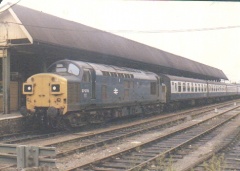English Electric Type 3
From PikkaWiki
(Difference between revisions)
| Line 34: | Line 34: | ||
==Prototype information== | ==Prototype information== | ||
| − | [[Image:37.jpg|right|240px]]The [http://en.wikipedia.org/wiki/British_Rail_Class_37 British Rail Class 37] was the longest-lived and most successful Type 3 diesel. Introduced in 1960 as a medium-powered replacement for steam locomotives such as the [[Jubilee]] and [[Standard 5]], it was a mainstay of the British locomotive fleet until the 21st century. | + | [[Image:37.jpg|right|240px]]The [http://en.wikipedia.org/wiki/British_Rail_Class_37 British Rail Class 37] was the longest-lived and most successful Type 3 diesel. Introduced by English Electric in 1960 as a medium-powered replacement for steam locomotives such as the [[Jubilee]] and [[Standard 5]], it was a mainstay of the British locomotive fleet until the 21st century. |
==Similar locomotives== | ==Similar locomotives== | ||
Revision as of 12:19, 7 October 2009
The EE Type 3 is a diesel locomotive in Project 1000.
Statistics and information
| Type: | General Purpose Diesel |
|---|---|
| Introduction: | 1960 |
| Withdrawal: | 2020 |
| Speed: | 80mph |
| Power: | 1750hp |
| Weight: | 107t |
| Tractive Effort: | 256kN |
| Replaces: | Jubilee, 8F |
| Replaced By: | BREL Class 58, EMD Class 66, Costar Junker |
Prototype information
The British Rail Class 37 was the longest-lived and most successful Type 3 diesel. Introduced by English Electric in 1960 as a medium-powered replacement for steam locomotives such as the Jubilee and Standard 5, it was a mainstay of the British locomotive fleet until the 21st century.Similar locomotives
The EE Type 3 represents all early medium-powered diesels, including Classes 37 and 40.

